Electrolysis computer simulation of a various metal-metal electrolytic cells. Choose metal electrodes, electrolyte, current and time. The simulation shows the change of mass for the anode and cathode. Animations at the particle level of the half-reactions that occur at each electrode, the migration of anions and cations in the electrolyte solution, and the electron movement in the wire.
Electrolysis Computer Simulation New HTML5 Version
For example, set two copper electrodes in aqueous copper(II) nitrate. Attach the electrodes to the DC current ammeter. Set the current at 8 amps and the timer at 15 minutes.
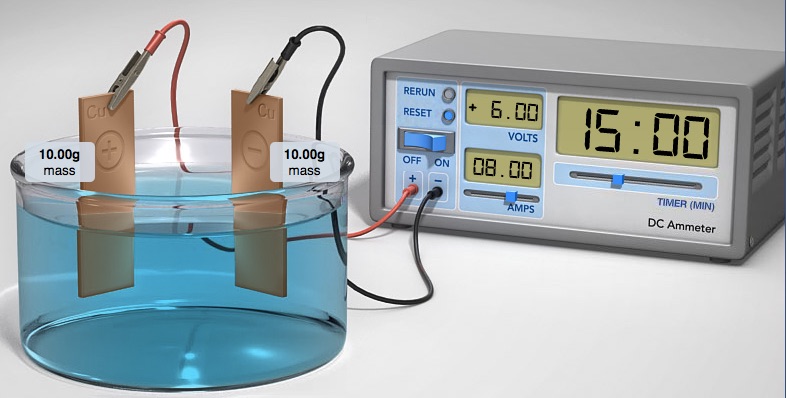
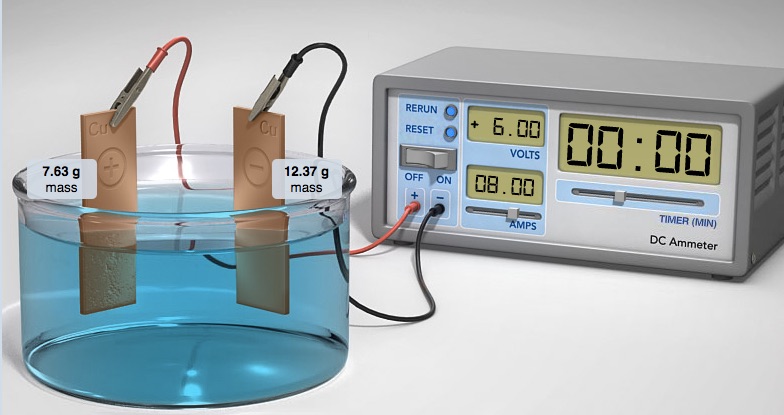
http://media.pearsoncmg.com/bc/bc_0media_chem/chem_sim/html5/Electro/Electro.php
©2016 Greenbowe, Abraham, Gelder University of Oregon, University of Oklahoma, Oklahoma State University, Pearson: Hoboken, NJ.
Available metals: aluminum, zinc, iron, copper, silver
Available aqueous solutions: aluminum nitrate, zinc nitrate, irron(II) nitrate, copper(II) nitrate, silver nitrate
Examples of set-ups: zinc-copper electrodes in zinc nitrate solution, plate zinc on copper
copper-copper electrodes in copper(II) nitrate solution, plate copper on copper
There is a student activity sheet that accompanies this computer simulation.
Web-page author: T. Greenbowe, University of Oregon. This page is under construction.
The following diagram identifies the component of a copper-copper electrolysis cell.
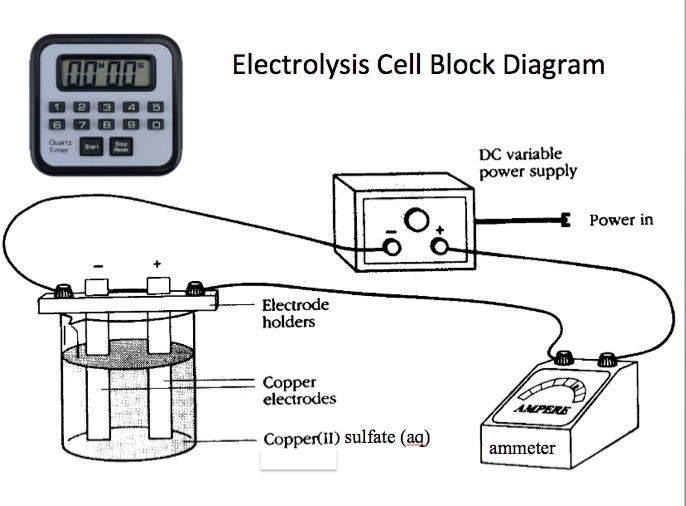
Animations at the particle level of the half-reactions that occur at each electrode, the migration of anions and cations in the electrolyte solution, and the electron movement in the wires.
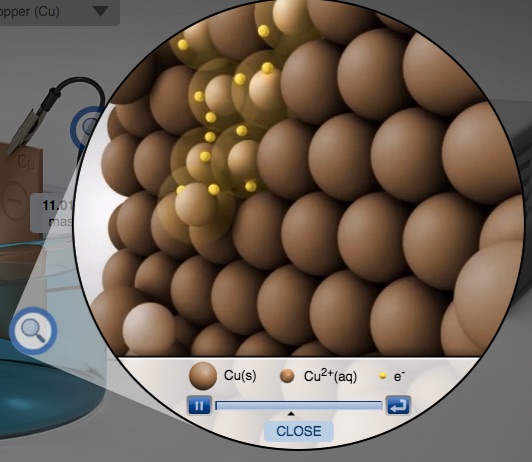
There is a student activity sheet that accompanies this computer simulation.
This versatile computer simulation can be used as part of a lecture presentation, POGIL classroom activity, as a component of a laboratory experiment involving electrolysis and electrochemistry, as an enhancement of lecture demonstrations, as a make-up laboratory experiment, as part of an end-of-chapter homework assignment, etc.
Have students complete a diagram of an electrolysis cell.
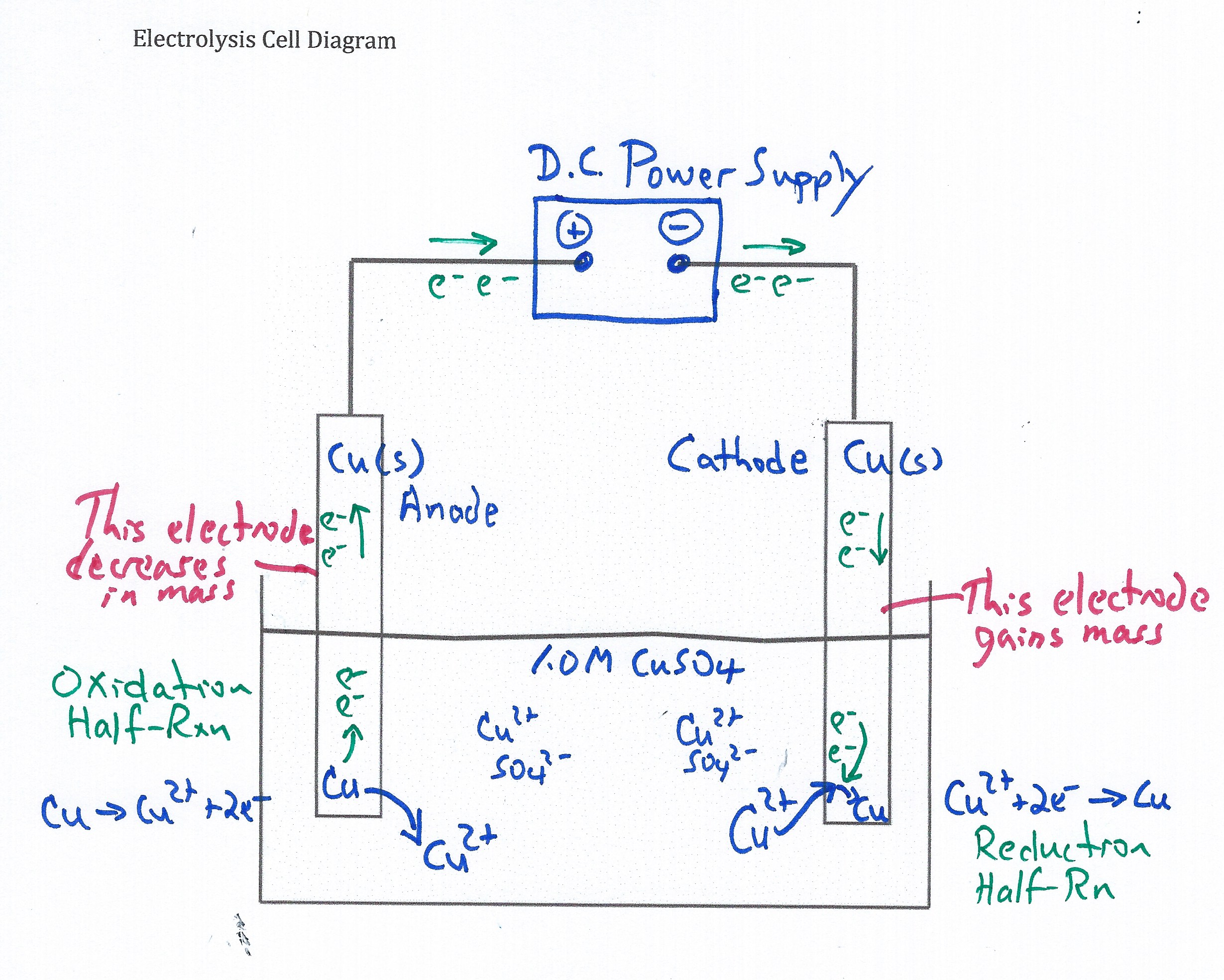
The electrodes are placed in 1.0 M CuSO4(aq) solution. The top of one Cu electrode is connected to the negative terminal of a D.C. Power Supply. The other Cu electrode is connected to the positive terminal of the D.C. Power Supply. When current is applied to the electrolysis cell copper(II) ions in solution are reduced to copper atoms at the cathode. Copper atoms on the anode are oxidized to copper(II) ions. The cathode gains mass, the anode looses mass. When the experiment ends, the electrodes are dried and the mass of each electrode weighed on the mini-balance. The time to plate the metal and the the current (amps) applied is used to calculate the theoretical amount of mass that should plate on the cathode. The actual mass obtained is compared to the theoretical amount calculated.
During the operation of the electrolysis cell, students would work to calculate the theoretical mass of copper plated on the cathode. Students also can predict the moles of electrons passed, the moles of copper plated, and the mass of copper plated when the current is applied for half of the time.
Table 17.7 Sample Data and Results of Calculations of a Copper-Copper Electrolysis Cell
| Reduction Half-reaction | Current (A) | Time (s) | Moles e- | Moles Metal | Mass of Metal (g) |
| Cu2+ + 2e- -> Cu | 8.00 | 900.0 | 0.0746 | 0.0746 | |
| Cu2+ + 2e- -> Cu | 8.00 | 450.0 | 0.0373 | 0.0373 | |
The effectiveness of this Electrolysis Cell demonstration can be enhanced when it is accompanied by an electrolysis cell computer simulation and computer animation at the particulate level (atom level).
Representing the oxidation and reduction half-reactions at the particle level helps studenrts understand the chemistry involved in electrolysis and makes connections between the symbols and the macroscopic levels (Johnstone, 1993).
Learning Objectives
1. Given a diagram of an electrolytic cell, identify the anode, cathode, direction of which electrons and ions move, the location of the oxidation half-reaction, the location of the reduction half reaction.
2. Given a description or a diagram of an electrolytic cell, write the oxidation half-reaction and the reduction half-reaction.
3. Relate the amount of product(s) generated in an electrolytic cell to the stoichiometry of the reduction half-reaction and to the amount of electrical charge passed in the cell.
4. At the particle level of representation (atom level), show how the number of electrons involved in a single reduction half-reaction, i.e. Zn2+ + 2e- -> Zn, scales up to the mole level: i.e. 1 mole Zn2+ + 2 mole e- -> one mole Zn.
5. Calculate the mass of product produced during electrolysis given the stoichiometry, the amount of electrical current passed in a specific time in the cell.
6. Calculate the quantity of of charged passed in an electrolytic cell, given the stoichiometry, and the amount of electrical current passed in a specific time in the cell.
7. Determine the relationship among coulombs, faradays, time, and reduction-half reaction for an electrolysis cell.
Footnotes
References
Gelder, J.I., Abraham, M.R., Greenbowe, T.J. (2015). “Teaching electrolysis with guided-inquiry.” In Sputnik to Smartphones: A Half-Century of Chemistry Education, M. Orna (ed.) ACS Symposium Series, Volume 1208, pp 141-154. American Chemical Society, Washington, D.C.
Sanger, M. Greenbowe, T. (1997). Common students misconceptions in electrochemistry: Galvanic, electrolytic and concentration cells. Journal of Research in Science Teaching, Volume 34, Issue 4, pages 377–398.
Garnett, P. J., & Treagust, D. F. (1992). Conceptual difficulties experienced by senior high school students of electrochemistry: Electrochemical (galvanic) and electrolytic cells. Journal of Research in Science Teaching, 29(10), 1079-1099.
Penelope Ann Huddle, Margaret Dawn White, and Fiona Rogers, “Using a Teaching Model to Correct Known Misconceptions in Electrochemistry,” J. Chem. Educ., Vol. 77, 2000, 104−110.
